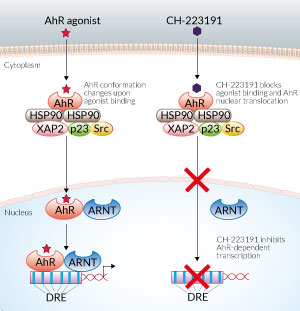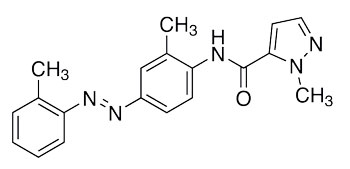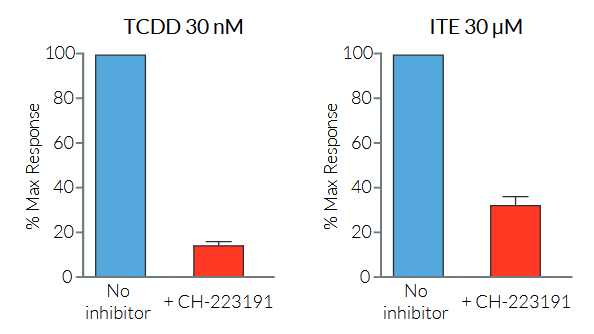CH-223191
| Product | Unit size | Cat. code | Docs. | Qty. | Price | |
|---|---|---|---|---|---|---|
|
CH-223191 2-methyl-2H-pyrazole-3-carboxylic acid; AhR Antagonist - InvitroFit™ |
Show product |
10 mg 2 x 10 mg |
inh-ch22
|
|

Inhibition of AhR signaling by CH-223191
AhR Antagonist
CH-223191 is a synthetic antagonist for the cytosolic aryl hydrocarborn receptor (AhR) transcription factor [1]. AhR is a ligand-dependent transcriptional factor able to sense a wide range of structurally different exogenous and endogenous molecules.
Mode of action:
CH-223191 exerts a ligand-selective antagonism and appears to be more effective on halogenated aromatic hydrocarbons such as the xenobiotic 2,3,7,8-tetrachlorodibenzo-p-dioxin (TCDD), than on polycyclic aromatic hydrocarbons and non-halogenated aromatic hydrocarbons such as FICZ and ITE, respectively [2].
Notably, CH-223191 is a pure AhR antagonist that does not stimulate AhR-dependent transcription even at concentrations up to 100 μM [1], unlike other AhR antagonists which display agonist activity at high concentrations. Moreover, CH-223191 is specific for AhR, displaying no affinity for the estrogen receptor, in contrast to other AhR antagonists [1].
InvivoGen's CH-223191 is of high quality, guaranteed free of bacterial contamination, and has been functionally tested on HepG2-Lucia™ AhR and HT29-Lucia™ AhR reporter cells.
Key features of CH-223191:
- A potent and specific AhR antagonist
- Ligand-selective antagonist activity
- InvitroFit™: each lot is highly pure (≥95%) and functionally tested
![]() Read our review on AhR's key role in the intestinal microbiota and immunity.
Read our review on AhR's key role in the intestinal microbiota and immunity.
References
1. Kim, S.H. et al., 2006. Novel compound 2-methyl-2H-pyrazole-3-carboxylic acid (2-methyl-4-o-tolylazo-phenyl)-amide (CH-223191) prevents 2,3,7,8-TCDD-Induced toxicity by antagonizing the aryl hydrocarbon receptor. Mol. Pharmacol. 69:1871-78.
2. Zhao B. et al., 2010. CH223191 is a ligand-selective antagonist of the Ah (Dioxin) receptor. Toxicol. Sci. 117:393-403.
Specifications
CAS number: 301326-22-7
Synonym: 2-methyl-2H-pyrazole-3-carboxylic acid
Solubility: 90 mM (30 mg/ml) in DMSO
Working concentration: 1 µM (333 ng/ml) to 30 µM (10.1 μg/ml) for cell culture assays
Formula: C19H19N5O
Molecular weight: 333.4 g/mol
Quality control:
- Purity ≥ 95% (UHPLC).
- The absence of bacterial contamination (e.g. lipoproteins and endotoxins) has been confirmed using HEK-Blue™ TLR2 and HEK‑Blue™ TLR4 cells.
- The inhibitory activity has been validated using cellular assays.
Contents
CH-223191 is available in two quantities:
- inh-ch22: 10 mg
- inh-ch22-2: 2 x 10 mg
![]() CH-223191 is shipped at room temperature.
CH-223191 is shipped at room temperature.
![]() Upon receipt, store at -20°C.
Upon receipt, store at -20°C.
![]() Protect this product from light.
Protect this product from light.
Details
The aryl hydrocarbon receptor:
The aryl hydrocarbon receptor (AhR) is a ligand-dependent transcriptional factor able to sense a wide range of structurally different endogenous and exogenous molecules, including the prototypic AhR agonist 2,3,7,8-tetrachlorodibenzo-p-dioxin (TCDD) [1-3]. AhR resides in the cytoplasm within a Hsp90:XAP2:p23:Src chaperone protein complex. Upon ligand binding, the complex undergoes conformational changes and translocates into the nucleus. The chaperones are released and AhR heterodimerizes with AhR nuclear translocator (ARNT). The AhR:ligand:ARNT trimer binds to dioxin response elements (DREs) in the upstream regulatory regions of AhR target genes, which include the cytochrome P450-dependent monooxygenase Cyp1a1, the AhR repressor (AhRR), and the IL-22 interleukin.
1. Stockinger B. et al., 2014. The aryl hydrocarbon receptor: multitasking in the immune system. Annu. Rev. Immunol. 32:403-32.
2. Hubbard T.D. et al., 2015. Indole and tryptophan metabolism: endogenous and dietary routes to Ah receptor activation. Drug Metab. Dispos. 43:1522-35.
3. Murray I.A. et al., 2016. Expression of the aryl hydrocarbon receptor contributes to the establishment of intestinal microbial community structure in mice. Sci. Rep. 6:33969.
Chemical structure of CH-223191:







